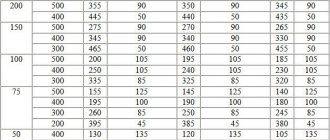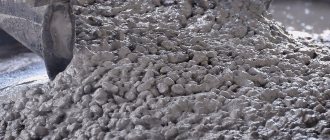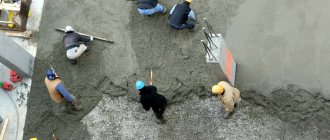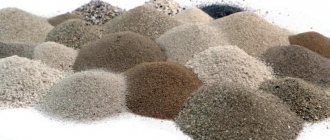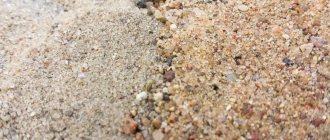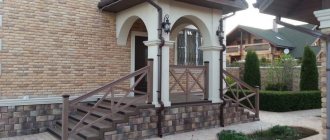The construction of modern buildings and structures is difficult to imagine without the use of concrete mixtures used in monolithic and reinforced concrete structures. Durable artificial stone materials of natural origin - concrete B 25, has gained enormous popularity and is widely used in road construction, bridge construction, construction of hydraulic structures and other civil and industrial facilities.
Concrete mixture B 25 in finished form Source sovet-sadovody.ru
Characteristics B25
The strength of b25 concrete is 327 kgf/cm2, so you don’t have to worry about the fragility of the building, the material will last for decades, which cannot be said about b15 concrete, since it is most often used in the construction of structures of low and medium weight.
A big plus is the ability to quickly harden due to the large amount of cement in the composition. The initial modulus of elasticity of concrete depends on consistency and density.
Most often used in industrial construction, when working with heavy structures. Specifications:
- B25 concrete means that the material can withstand pressure of 250 atmospheres. At the same time, it will not crack, its integrity will not be compromised;
- concrete class B25 – concrete grade M 350, belongs to the class of heavy concrete;
- the mobility of the material is P2-P4, but it can be increased with the help of additives;
- the density of concrete B25 is 2-2.5 t/m3 (specific gravity of concrete B25 is 2000 to 2500 kg/m³), which indicates its high strength and resistance to various types of impact;
- the volumetric weight of concrete is 25 - 2502 kg, the material is heavy, therefore it is used in certain types of work.
Class B25 is a grade of concrete M350
Advantages and disadvantages
Concrete mixture of this class has gained popularity due to its unique combination of technical characteristics and performance indicators. The undoubted advantages of this material include:
- Increased strength indicators. When exposed to significant compressive forces, concrete masses retain their integrity. Concrete surfaces work successfully under conditions of active abrasion.
- High degree of mobility. B25 concrete is supplied to heights by concrete pumps and quickly placed into monolithic structures. Additional elasticity of the mixture is increased by special plasticizing additives.
- Adjustable level of frost resistance. To achieve the required frost resistance, frost-resistant additives are added during the preparation of concrete, preserving the integrity of monolithic structures in conditions of negative temperatures.
- Long service life. Class B 25 concrete retains its strength characteristics for several decades and does not deform under the influence of an aggressive environment.
Correspondence between concrete class and strength grade Source betonli.ru
Features of the material
It is class B25 concrete that is one of the most popular materials in conventional and industrial construction. The material has high strength, which is why it is often used in pouring the foundations of buildings or other load-bearing structures.
The main advantages are:
- waterproof. Does not allow water to pass through, as it has a W8 rating. Waterproof concrete is ideal if the foundation is built on land with a high groundwater level;
- frost resistance. The material can withstand up to 200 cycles of freezing and thawing, after which it does not lose its shape;
- mobility. This function helps to compact polymer concrete. Indicators increase with the addition of plasticizers.
How to make B25 concrete mix with your own hands
Concrete grade B25 can also be prepared at a private construction site if you stock up on a concrete mixer. It is impossible to achieve homogeneity of the solution manually due to the crushed stone included in the composition.
Scheme of proportions of concrete mass
Having calculated the required amount of ready-made concrete, all components are delivered to the site in the required quantities (taking into account proportionality). When purchasing, you need to pay attention to the quality of materials. You should not use stale cement that has lost its friability and friability.
It is recommended to sift the sand before use to get rid of possible impurities. If the material is not clean enough, it should be washed further. The composition of the water also matters - it is advisable to use drinking water. Its proportion in the solution can be slightly reduced if wet components are used in the process.
When preparing concrete, follow the following sequence:
Scheme for preparing concrete mixture
- First, all dry materials are loaded into a concrete mixer and mixed thoroughly;
- continuing to stir, gradually add water;
- if plasticizers are added to the composition, this is done during the process of pouring water;
- Solid fillers, previously moistened, are poured into the unit last.
The solution continues to be stirred until it becomes homogeneous. Please note that the resulting mixture must be used within 2 hours.
If you are not sure that you will get high-quality, high-strength concrete at home, you should contact the manufacturer. But at the same time you will have to adjust to the extra costs of money.
Video on the topic: Brand and class of concrete - what is the difference?
Publications on the topic
Determining the proportions of concrete in buckets for a concrete mixer
How long does it take for the concrete mass to dry under the influence of different environmental conditions?
Plasticizers applicable for the production of cement mortar
Application area
There are many areas of application for this type of concrete. It is the material of this brand that is used in various construction works:
- manufacturing of columns, piles, beams;
- in pouring monolithic foundations and pool bowls;
- in the process of constructing monolithic walls;
- for pouring road slabs at airports.
Class B25 is one of the most popular in commercial and industrial construction
Where is it used?
High-strength concrete is ideal for foundations and load-bearing supports. The material was appreciated as a good solution for high requirements. I used it myself when working with the foundation. But B25 concrete is poured during construction:
- frames;
- floors;
- load-bearing structures;
- piles;
- bridges;
- tunnels;
- runways at airfields.
Wherever strength is needed, B25 is suitable. Individual construction, industrial construction, various offices - it can be used everywhere.
RECOMMENDED ON THE TOPIC
- Cement grades: application and interpretation
- The use of non-flammable...
If you want to use B25 concrete and have no experience, I advise you to study GOSTs and SNiPs. They are written dryly and regimented, but they give a detailed idea of even the little things.
For example, why B25 (I answer - it can withstand pressure of 250 atmospheres without damaging the structure).
Or the documents will clarify some obscure things like vibration compaction. How many times have I watched the construction process, I have never seen technology used. At best, everything is done manually. Or in general, they’ll sketch it, accept/pressure and that’s it. But to obtain better results and higher strength, vibration compactors are simply necessary. Okay, I stirred a couple of buckets of the mixture, sealed it, knocked and it was done.


